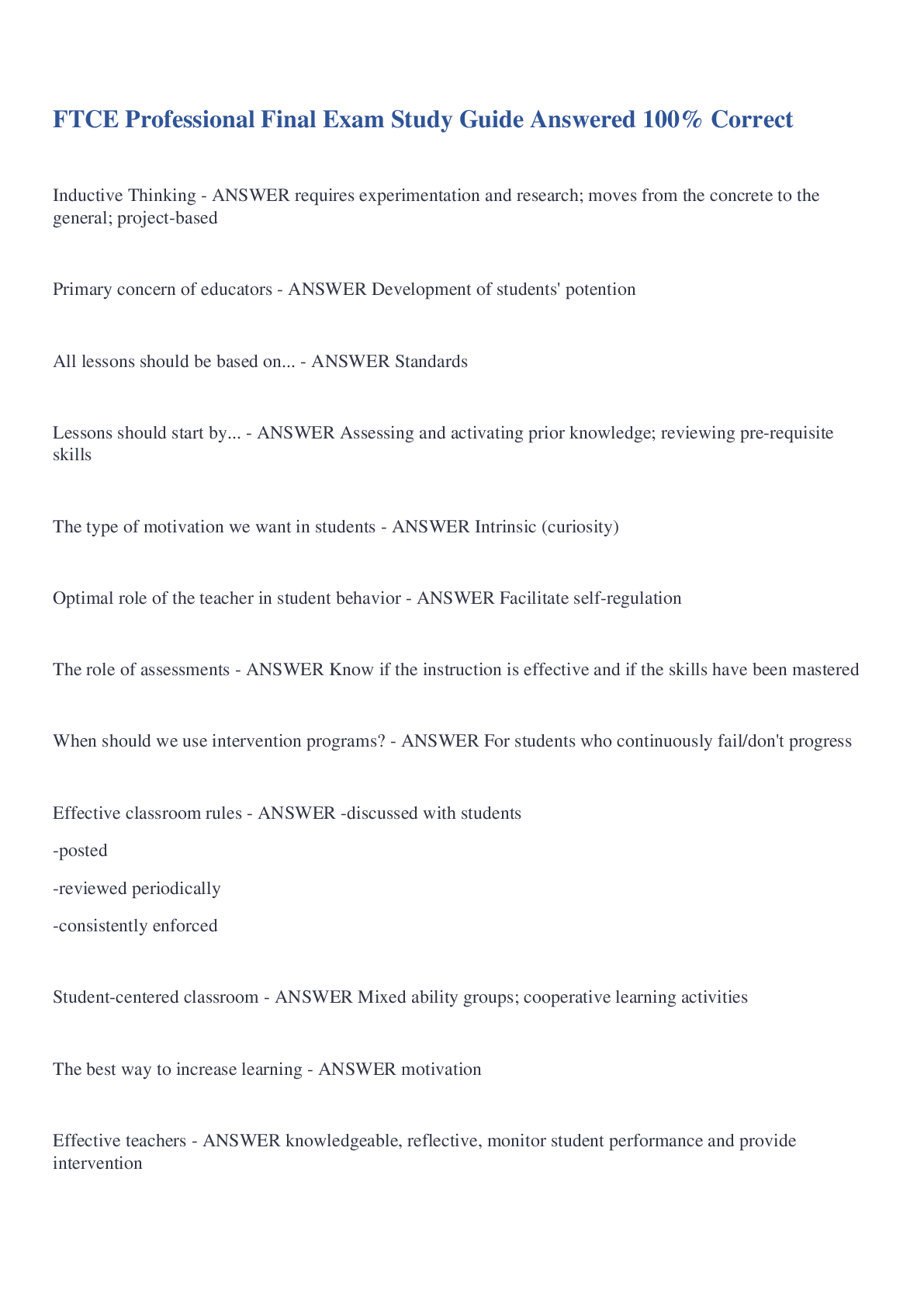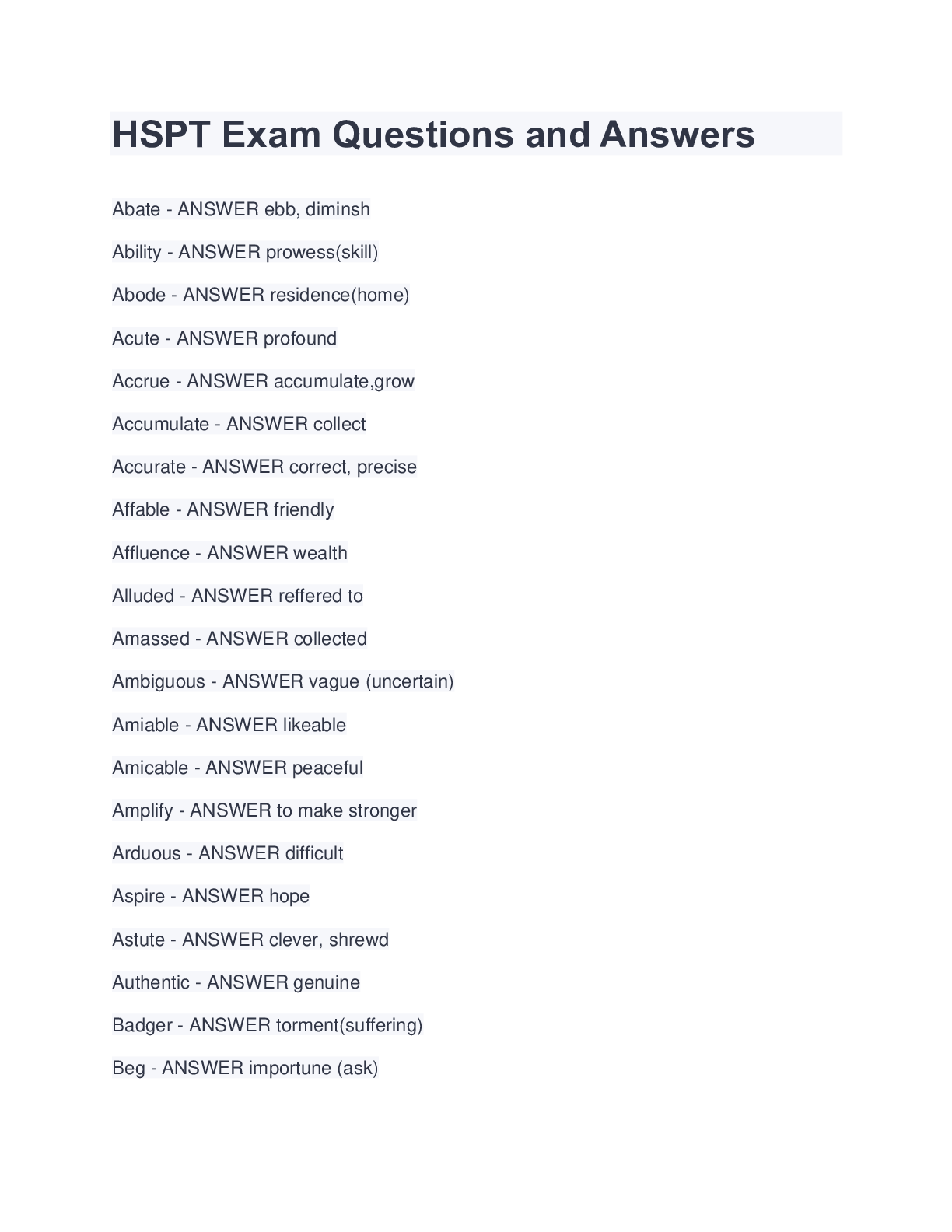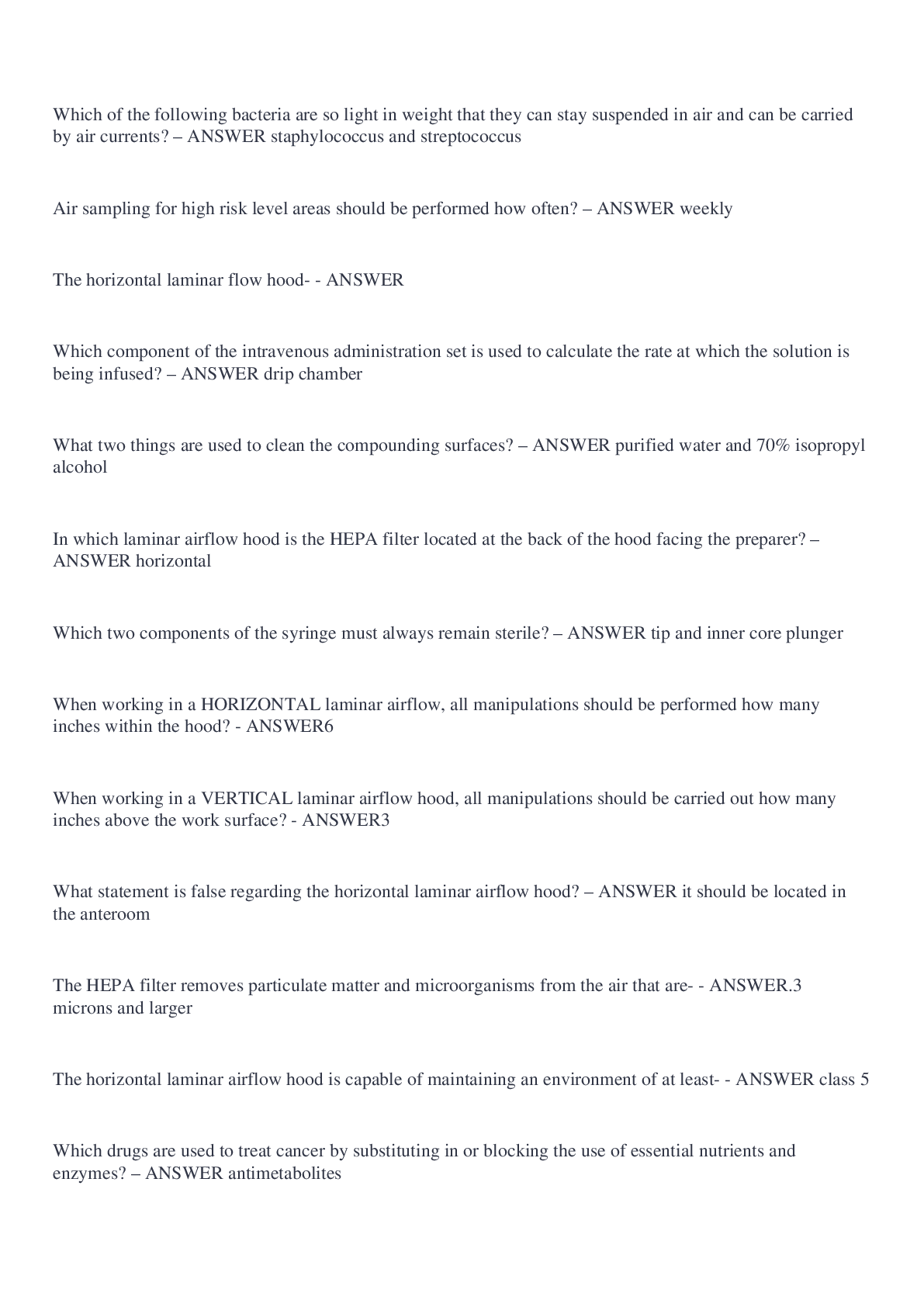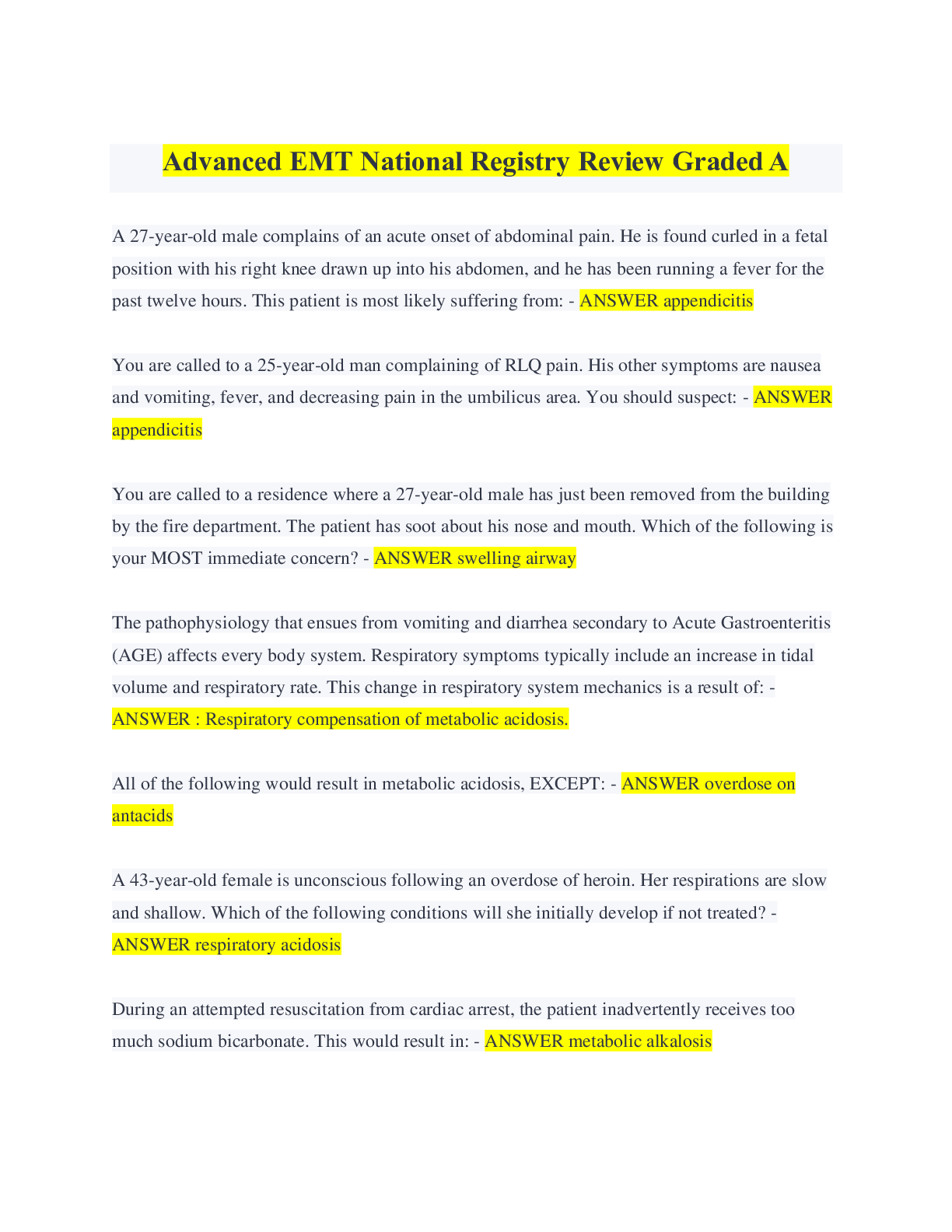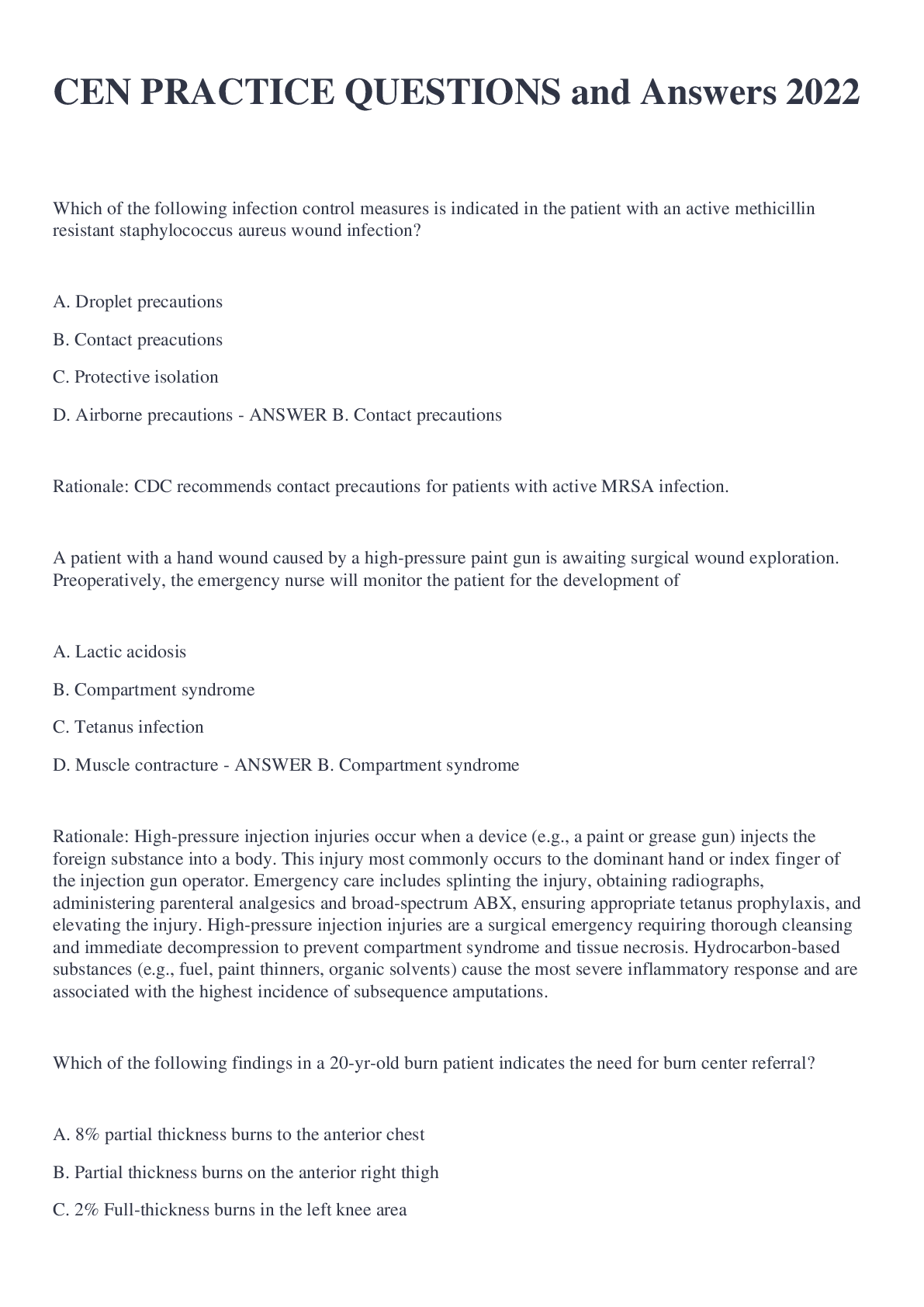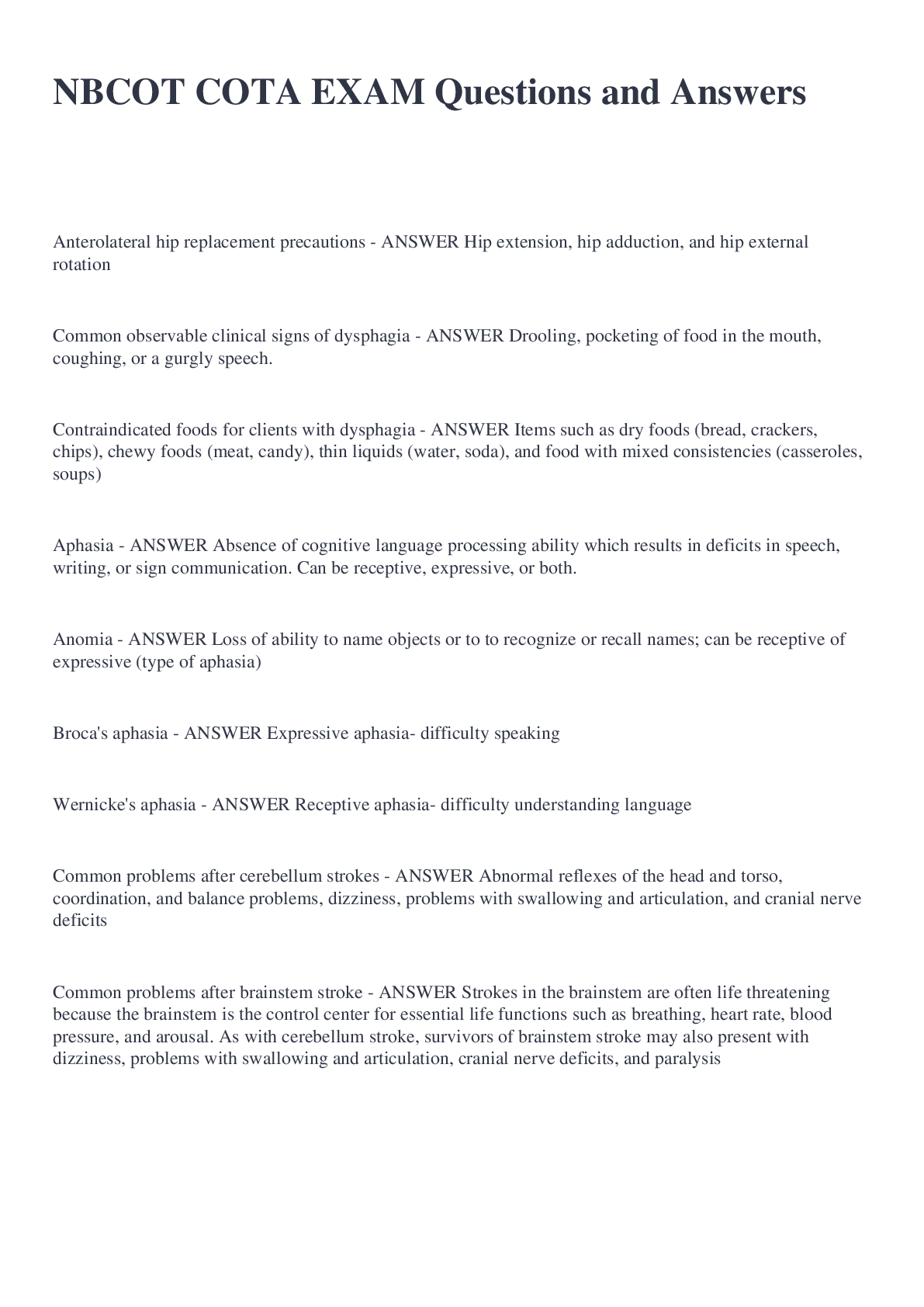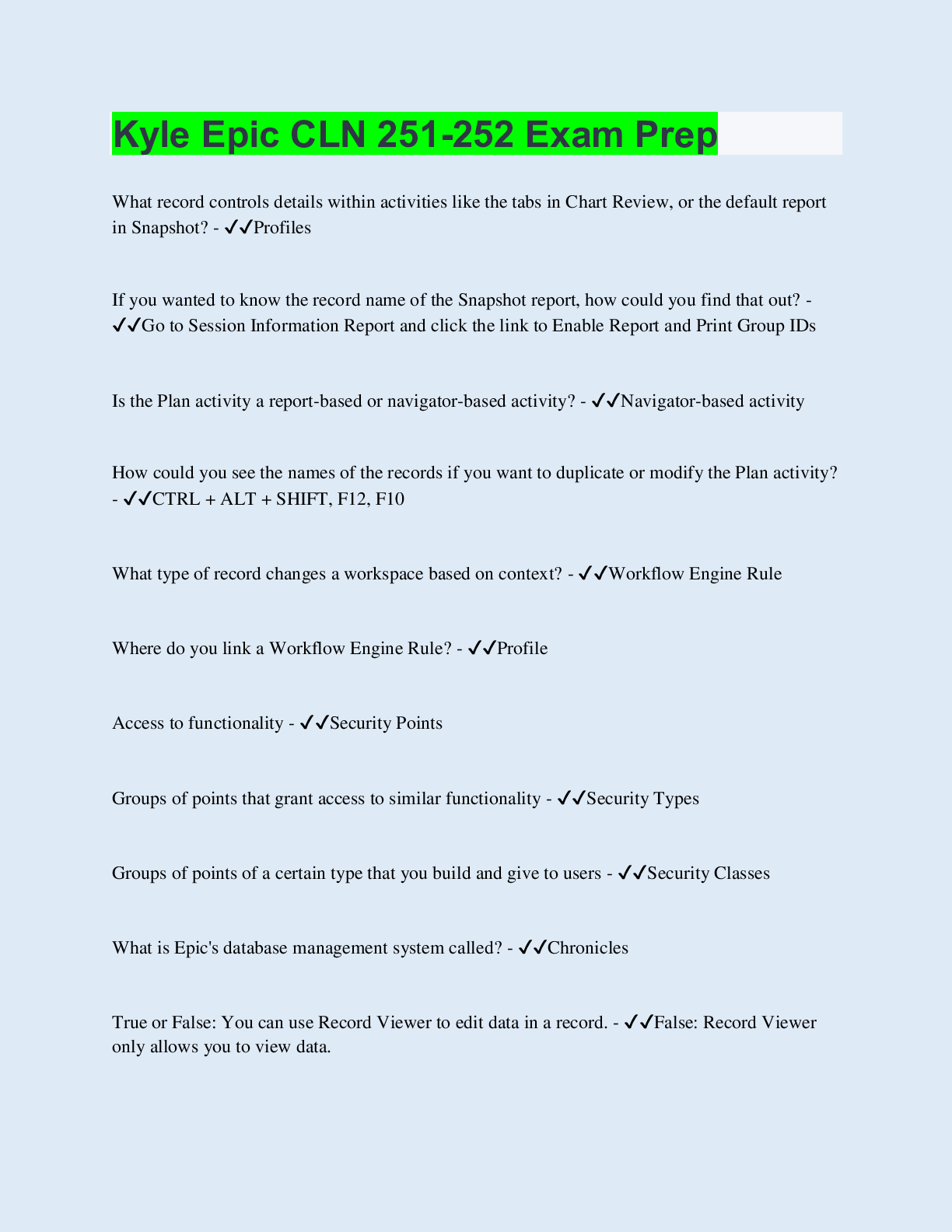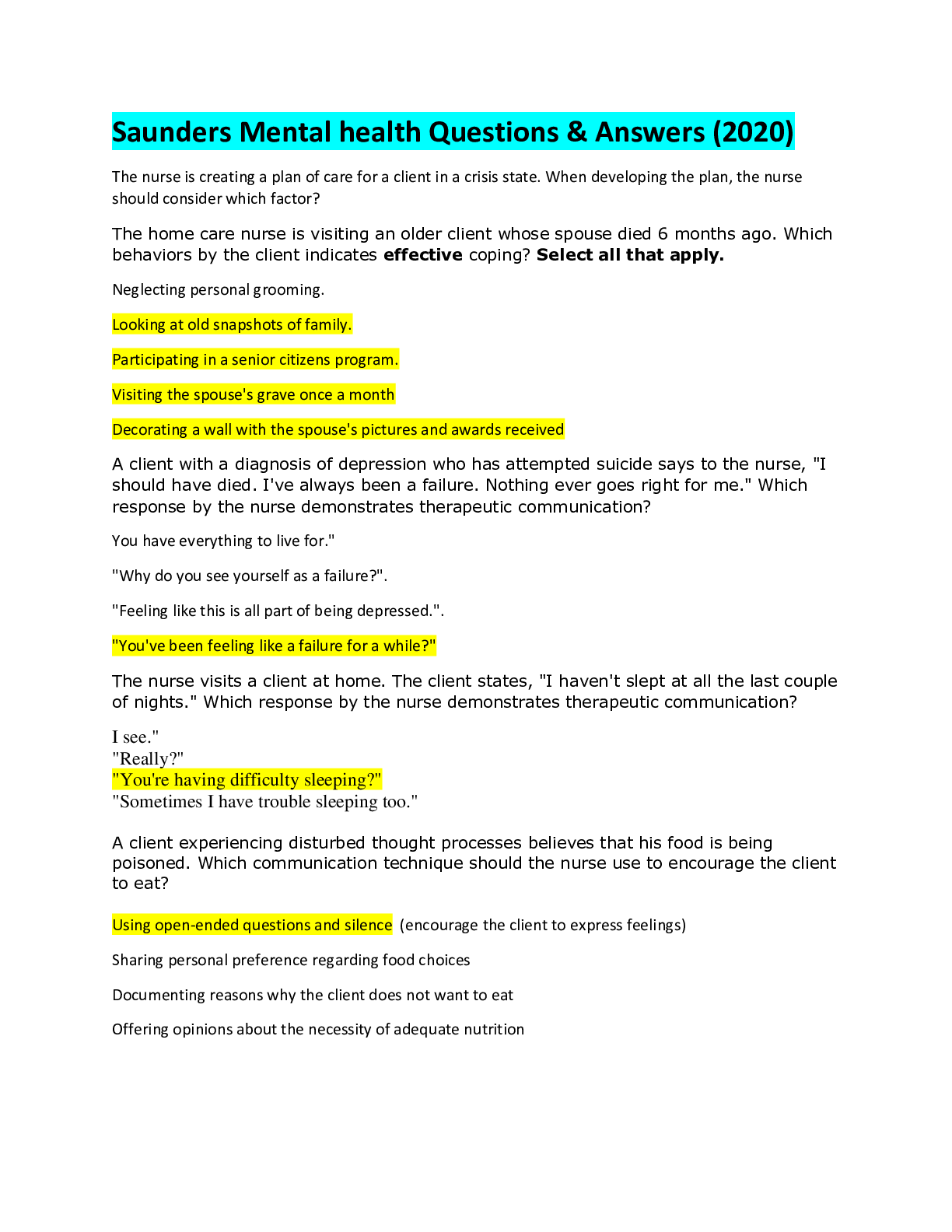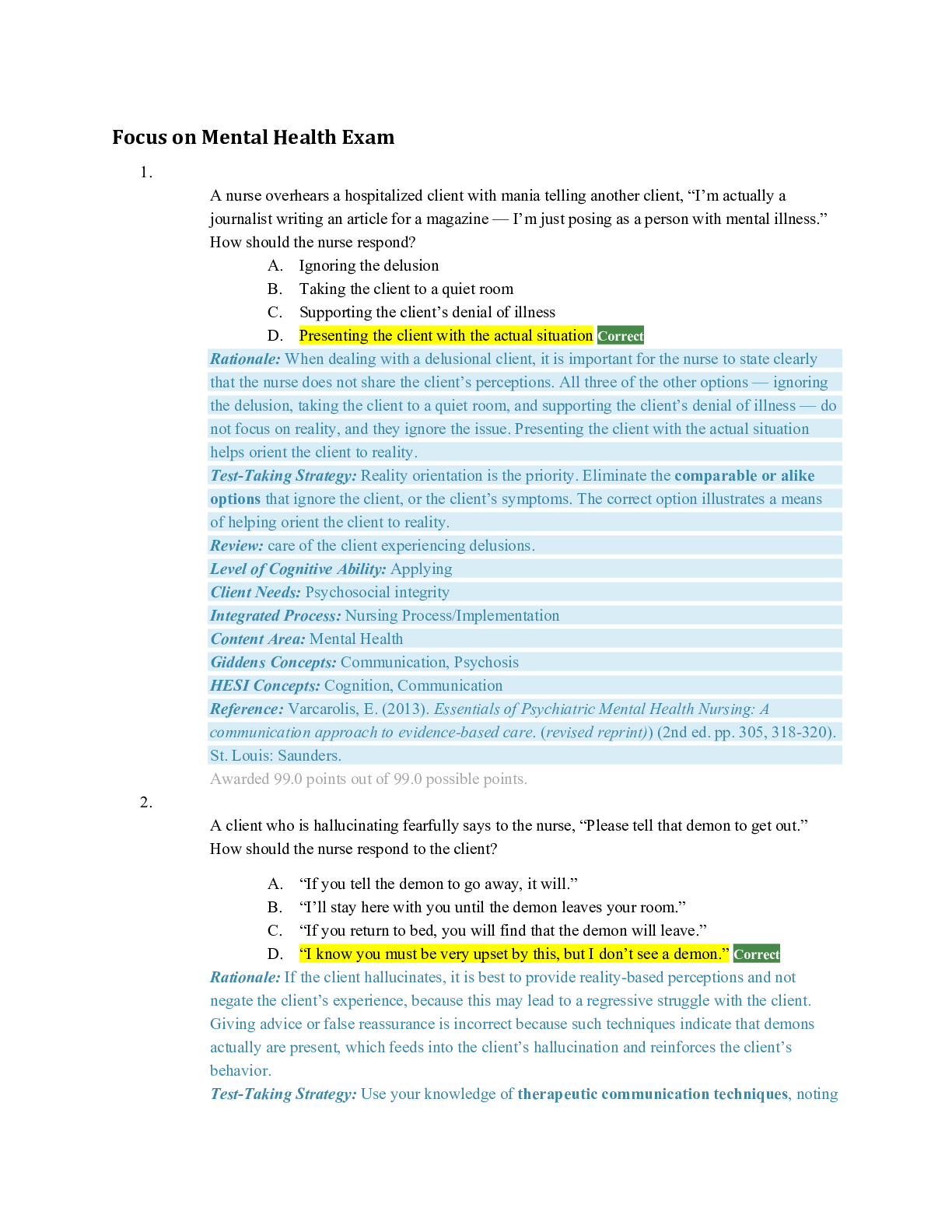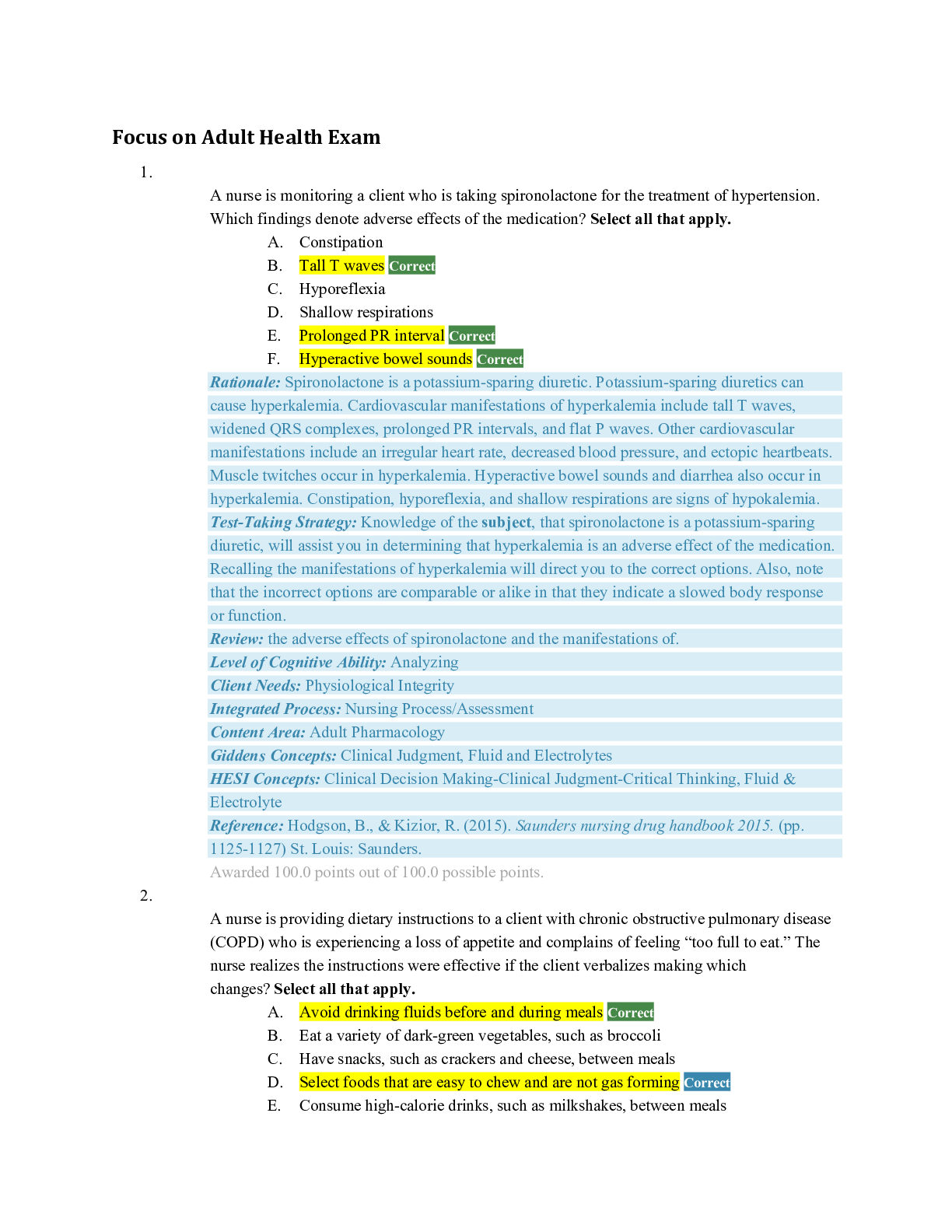Health Care > EXAM > NSG6430 Women's health Exam Questions and Answers (All)
NSG6430 Women's health Exam Questions and Answers
Document Content and Description Below
Which STI is confirmed with the Western Blot? - ANSWER HIV Which 2 STI's are treated with metronidazole 500mg BID for 7 days? - ANSWER Bacterial Vaginosis and Trichomoniasis Which STI present wi... th clue cells on a saline wet mount - ANSWER Bacterial vaginosis Which STI is treated with 2 grams of metronidazole as a single dose? - ANSWER Tricomoniasis What is the screening test for HIV? - ANSWER EIA or Elisa What is the confirmed test used after a positive EIA oe ELISA test for HIV? - ANSWER Western Blot What are the option for medication prescription given to a non-pregnant patient with Chlamydia - ANSWER Doxycycline 100mg BID x 7days What is the medication management for Gonorrhea? - ANSWER Ceftriazone (Rocephin) 250mg or Cefixime AND Azithromycin 1 gram oral pillx1 or Doxycycline 100mg oral BID x 7 days (dual purpose for chlamydia and gonorrhea). What is the medication management for trichomoniasis in pregnant and non-pregnant patients? - ANSWER Metronidazole (flagyl) 2 gram single doses orally. What are the three assessment findings in a patient with primary Syphilis? - ANSWER Chancre at sire of inoculation, chancre may go away unnoticed in females, regional lumphadectomy. Non-pharmacological way for urinary incontinence - ANSWER Weight loss, Kegel, and pessary biofeedback A woman came in with a 99.8 fever complaint of dysuria. Nitrire and Blood is positive - ANSWER Treat for UTI Painless ulcer treat with IM Benzathine - ANSWER Primary Syphilis Hormone replacement therapy for total hysterectomy - ANSWER Estrogen Only Chlamydia treatement - ANSWER Single dose of azithromycin antibiotic Trichomoniasis treatment - ANSWER *Metronidazole (Flagyl) *Sexual partners need evaluation, testing, and treatment also The safest way for women with HIV should deliver baby if the viral load is high or unknown close to the time of delivery. - ANSWER C-section The most common cause of chronic pelvic pain for women in the prime of their reproductive years is - ANSWER Endometriosis A fifty-two year old female patient comes in for her annual well-women examination. Her LMP was fourteen months ago without any break through bleeding. She also has developed some hirsutism. You would document this as____ - ANSWER Menopause A definitive diagnosis of endometriosis cannot be made until which of these is completed? - ANSWER Exploratory Laparoscopy A 24 yo female came in with the CC of vaginal itching in addition to thick mucoid discharge. She also has some mild urinary discomfort. A wet mount preparation using potassium hydroxide reveals a negative whiff test and a few clue cells, WBS were too numerous to count. The most likely diagnosis is___ - ANSWER Chlamydia A sixty-five year old obese female with type II DM present to your office with a complaint of vaginal itching and burning for 2 years. She has tried douching with an OTC cream with no relief. On examination noted vulva is deep red with some thick white adherent material. Which of the following conditions would be most likely cause of her conditions would likely cause of her symptoms? - ANSWER Fungal infection Anticholinergics medications are a type of treatment for - ANSWER urge incontinence What phase begins with menses cessation and ends with ovulation? - ANSWER Follicular phase A NP is educating a patient who has just been diagnosed with polycystic ovary syndrome (PCOS). She needs to be aware that PCOS is associated with which of the following clinical manifestation? - ANSWER Obesity, infertility You are counseling an 11 yo girl and her mother about HPV vaccines, Gardasil. Amanda is Tanner stage IV at this visit. In counseling this family, you tell them that HPV vaccine - ANSWER 9-14 2 doses and 15-26 3 doses 6-12 months apart. You are instructing a patient in the proper use of the diaphragm, a barrier contraceptive method. Which of the following would you include in your instruction? - ANSWER The diaphragm is more effective when use with a spermicidal jelly. Cara is in the clinic for what you have diagnosed as dysfunctional uterine bleeding. She is concerned about why this is happening to her. The most common cause of DUB is? - ANSWER Anovulation What phase begins with ovulation and ends with menstruation? - ANSWER Luteal phase Polycystic ovaries predispose women to a higher incidence of: - ANSWER Endometrial cancer General health and physical exam including breast examination, pelvic with Pap smear, screening tests, counseling, immunizations, risk factors, and patient concerns. - ANSWER breast examination, pelvic with Pap smear, screening tests, counseling, immunizations, risk factors, and patient concerns. Tanisha is a 20 yo women who presents with extreme irritability and mood swings, bloating, constipation, fluids retention, and headache. She tearfully tells you "This happens every month in my cycle, I get like a crazy women, lashing out at everyone. I'm afraid I'll lose my job if I can't stop this. Sometimes it's so bad I just want to quit living. I need help." Tanisha's symptoms are typical of what disorder? - ANSWER Premenstrual dysphoric disorder (PMDD) 1. What are the criteria used to make a diagnosis of bacterial vaginosis? - ANSWER A. Clue cells on microscopic examination of wet mount, the presence of an amine odor when vaginal discharge is mixed with KOH 10%, an increased amount of white, homogeneous vaginal discharge and a vaginal pH of >4.5B. Clue cells on microscopic examination of wet mount, the presence of an amine odor when vaginal discharge is mixed with KOH 10%, an increased amount of white, homogeneous vaginal discharge and a vaginal pH of <4.5C. Hyphae on microscopic examination of wet mount, the absence of an amine odor when vaginal discharge is mixed with KOH 10%, an increased amount of white, clumpy vaginal discharge, and a vaginal pH of <4.5 Answer: A - Clue cells on microscopic examination of wet mount, the presence of an amine odor when vaginal discharge is mixed with KOH 10%, an increased amount of white, homogeneous vaginal discharge, and a vaginal pH of >4.5 describe the Amsel criteria used to diagnose bacterial vaginosis What is the ASCCP recommended management for an ASCUS (atypical squamous cells of undetermined significance) pap result with a positive high risk HPV 16 cotest in a 26 year old woman without a history of abnormal pap smears? - ANSWER A. Colposcopy Answer: A - The ASCCP guidelines recommend colposcopy for the management of an ASCUS (atypical squamous cells of undetermined significance) pap result with a positive high risk HPV 16 cotest in a 26 year old woman without a history of abnormal pap smears. On clinical exam, you detect a 2cm x 1cm non-tender, smooth, round, rubbery, mobile mass in the upper outer quadrant of your 32 year-old nulligravid patient's right breast. This mass is most likely: - ANSWER Fibroadenoma Answer: C - A 2cm x 1cm non-tender, smooth, round, rubbery, mobile mass in the upper outer quadrant of the right breast of a 32 year-old nulligravid woman, detected on clinical exam, is most likely a fibroadenoma. Fibroadenomas are the most common breast pathology found in reproductive-aged women, with an estimated prevalence of 9%. Breast cancer is less common in this age group, and on exam is usually firm and non-mobile. Which of the following HPV protocols is correct? - ANSWER B. Boys and girls age 9-14 should receive two doses of 9-valent HPV vaccine (Gardasil 9) six to twelve months apart The HPV vaccine (Gardasil 9) is indicated for: - ANSWER Answer: A - The HPV vaccine is indicated for all children and adults aged 9-26. Vulva cancer - ANSWER r/t HPV infection or vulva intraepithelial neoplasia (VIN) disorder, 50% asymptomatic, majority are squamous cells carc. Staging tumor-node-metastisize (TNM). HPV - ANSWER most common STI in US. Found in 99.7% of cervical malignancies Cervical cancer - ANSWER 99.7% due to HPV (types 16&18). Squamous cells carc 80-90%. Abnormal vaginal bleeding endometrial cancer - ANSWER Type 1: estrogen-dependent. most common; excess in endogenous or exogenous estrogen (unopposed by estrogen) Type 2: 10% of cases, unrelated to estrogen or endometrial hyperplasia, endometrium atrophic or has polyps. Hereditary: form 10% of cases; hereditary non-polyposis colorectal cancer (HNPCC). endometrial cancer - ANSWER Risk fx: estrogen therapy, tamoxifen, early menarche/late menopause, hx of infertility or nulliparity, obesity, DM, ovarian CA. More common in postmenopausal female. S/Sx: abnormal uterine bleeding, no screening. Endometrial biopsy & transvaginal ultrasound. D&C is the gold standard for assessing uterine bleeding Decrease risk of endometrial cancer - ANSWER Combined oral contraceptive, physical activity, low-fat diet, controlling other risk factors. ovarian cancer - ANSWER highest mortality rate, epithelial CA 80-90%; risk factors: family history in first degree relative; BRCA1 or BRCA2 genetic mutation. Vague symptoms like abdominal bloating, dyspepsia. CA 125 or ultrasound. Standard surgical procedure: total abdominal hysterectomy, bilateral sloping-oophorectomy, peritoneal cytology, omentectomy, pelvic and para-aortic lymph node sampling, scraping of undersurface of diaphragm, peritoneal biopsies. Menopause - ANSWER Perimenopause: 2-8 yrs after menopause Early postmenopause: first 5 yrs following menopause Late postmenopause: 6+ yrs after last menstrual period. hormone replacement therapy - ANSWER Estrogen for those with hysterectomy. Estrogen-Bazedoxifene therapy: combination formula for women with an intact uterus. Urinary Incontinence Treatment - ANSWER Behavioral strategies (bladder training, pelvic floor strengthening), pharmacologic (anticholinergic medications, alpha adrenergic medications), surgical (relief of mechanical obstruction) urinary tract infection (UTI) - ANSWER 50% E. coli and 15% Staph saprophyticus. - 3 days regimen, sx should resolve in 72 hours w/ABT. Vaginitis - ANSWER numerous white blood cells Vaginosis - ANSWER Not associated with WBC. unpleasant-fishy odor; pH >4.5. Tx: Metronidazole 500mg BID x 7d Vulvovaginal candidiasis - ANSWER A yeast infection of the vagina and tissues at the opening of the vagina (vulva). cottage cheese. Cervicitis - ANSWER Tx: azithromycin 1 gram orally in a single dose. Chlamydia - ANSWER Tx: azithromycin 1 gram x1dose OR doxycycline 100mg orally BIDx 7days Genital warts treatment - ANSWER Surgical removal, cryotherapy; imiquimod 3.75% or 5% cr, podofilox 0.5% solution/gel Gonorrhea treatment - ANSWER Gonorrhea TX: IM Ceftriaxone Cover Chlamydia with: azithromycin : 1 g orally as a single dose doxycycline : 100 mg orally twice daily for 7 days [Show More]
Last updated: 2 years ago
Preview 1 out of 6 pages
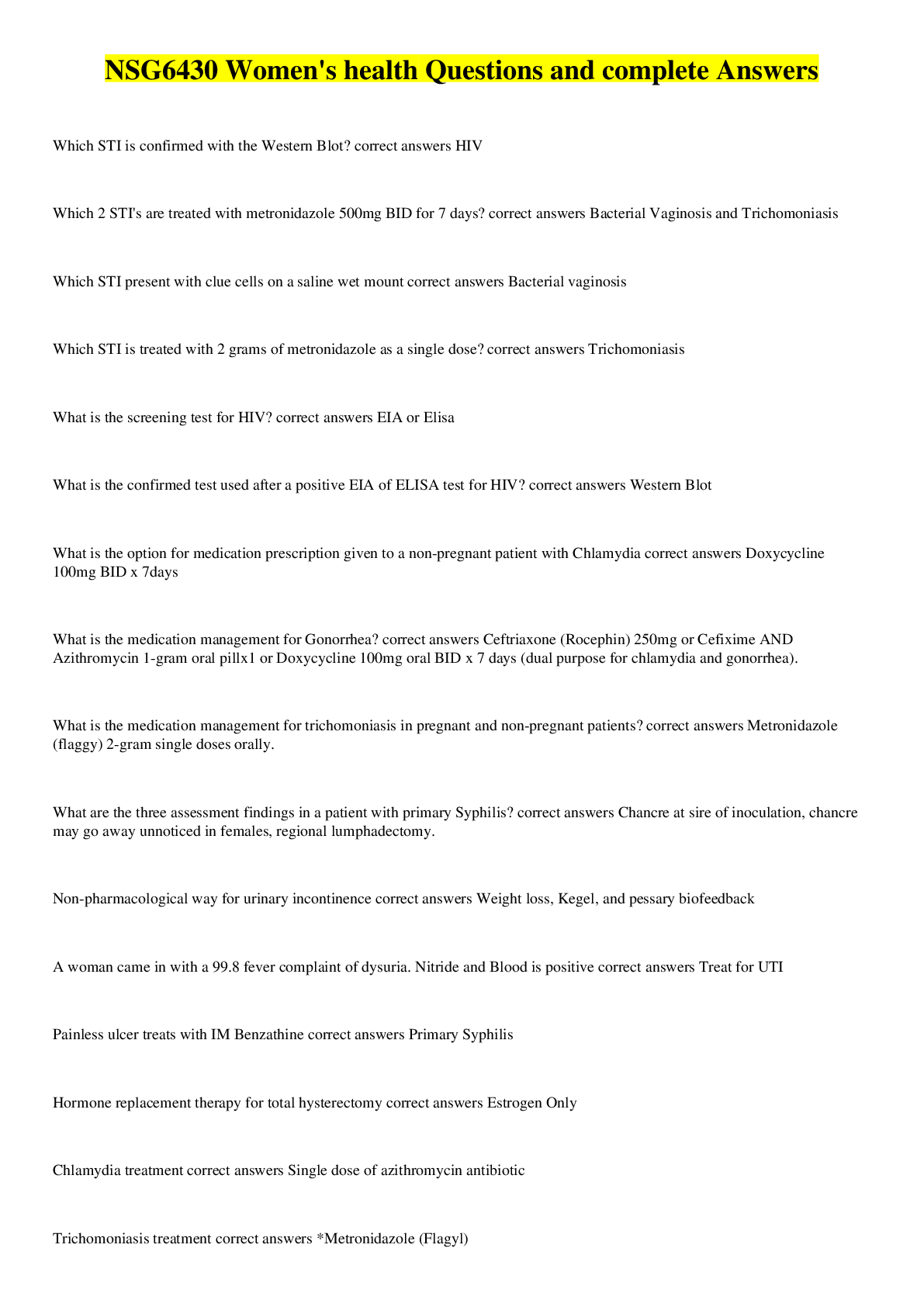
Buy this document to get the full access instantly
Instant Download Access after purchase
Buy NowInstant download
We Accept:

Reviews( 0 )
$5.00
Can't find what you want? Try our AI powered Search
Document information
Connected school, study & course
About the document
Uploaded On
Oct 03, 2022
Number of pages
6
Written in
Additional information
This document has been written for:
Uploaded
Oct 03, 2022
Downloads
0
Views
51


